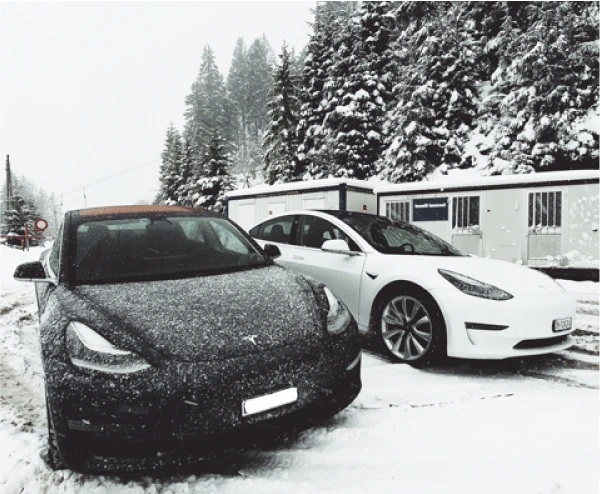There are many misconceptions about EVs, including how they perform in cold weather. One frequently asked question is, “Does cold weather affect EV range?” Yes, it does, in a nutshell. Keep reading; this post will look at charts and compare the data in different temperatures. These data include driving ranges, other EV models(USA editions), temperatures and HVAC (Heating, ventilation and Air-conditioning) usage.
Jump Ahead
- ➤ Understanding how the Electric Vehicle battery works?
- ➤ Temperature & its effects on Lithium-ion Batteries.
- ➤ Comparing Ranges based on HVAC usage.
- ➤ Diving range in different temperatures.
- ➤ Steps to increase EV range during cold temperatures.
Understanding how Electric Vehicle battery works?
To begin, it is critical to comprehend how EVs function. An electric vehicle is powered by a Lithium-ion battery, which stores energy to power an electric motor. While driving, the battery gradually loses energy, resulting in a reduction in range. Research has shown that in cold temperatures, the driving range is significantly impacted. Studies have also shown the overall performance of EVs during the winter is substantially lower than in summer. This is due to the chemical reactions that take place in Li-ion batteries at various temperatures. Several factors, including battery size and driving habits, also determine the range of an EV.
Temperature Affecting Lithium-ion Batteries
Most EV batteries function within an optimal operating temperature range. Temperatures that are too high or too low can affect the chemical reactions in the battery. Lithium-ion batteries, which are commonly used to power EVs, perform best at temperatures ranging from about 20°C to 40°C (68°F to 104°F). If the temperature rises too quickly, the battery may overheat. If it falls too low, it will deliver slower charge and discharge rates with reduced capacity.
On high temperatures:
It accelerates the battery’s chemical reactions, causing the battery to overheat, leading the materials to degrade faster, and in turn, reducing battery life by increasing internal resistance.
Low temperatures:
Colder temperatures slow down the chemical reactions in the battery, reducing its capacity and ability to deliver power. Extremely low temperatures may cause physical changes such as the formation of ice crystals, which can damage the materials and chemical compositions in the battery.
Comparing Ranges based on HVAC usage
When HVAC is turned OFF: Research conducted by American Automobile Association Inc. evaluates the effect on the driving range when HVAC is in use at 20°F(-7°C), 75°F(24°C) & 95°F(35°C). The below bar chart gives a clear view of the differences in the ‘cumulative driving range’ tested on different EV models.
At normal temperatures (24°C), all EV models are able to obtain their maximum range when the HVAC mode is off. At cold temperatures (-7°C), the driving range is at its lowest range compared to the other temperatures.
When HVAC is turned ON: Testing when the HVAC mode is ON significantly impacts an EV’s range performance. Turning on the HVAC mode enables heating, ventilation, and air conditioning to function simultaneously. The below chart shows the difference in performance.
Looking at the chart above, when in use the HVAC has a significant impact on the EV’s driving range, due to excess power consumption being directed to the HVAC system.
Diving range in different temperatures.
EV range on Cold Temperatures:
Lithium-ion batteries found in EVs are especially sensitive to cold temperatures. On average, HVAC use at -6°C resulted in a 41 per cent decrease in combined driving range and a 39 per cent decrease in combined equivalent fuel economy (compared to testing conducted at 24°C), according to a study by the American Automobile Association Inc. This means that if an EV has a range of 320 KM in ideal conditions, it may only have a range of 128 KM or less in extreme cold.
EV range on Warm Temperatures:
However, extremely cold temperatures aren’t the only thing that can reduce EV range. Temperatures around 30°C can also cause a reduction in range. According to the American Automobile Association Inc., on average HVAC use to accompany a 35°C temperature resulted in a 17 per cent decrease in both combined driving range and combined equivalent fuel economy (when compared to testing conducted at 24°C). The battery still has to work harder to produce the same amount of power, even if the conditions aren’t as severe as in extremely cold temperatures.
Measures to follow to increase range during cold temperatures.
So what can EV owners do to reduce the effects of cold weather on the range? When not in use, one option is to keep the EV in a garage or other sheltered area. This can help keep the battery slightly warmer, improving performance. Another option is to pre-heat the car using the built-in heating system or a smartphone app before driving. This can aid in warming up the battery and increasing range.
It’s also worth noting that driving habits can significantly impact EV range regardless of the weather. Driving at high speeds, accelerating quickly, and frequently using heating or air conditioning can reduce range. EV owners can maximize their range and reduce the impact of cold temperatures by driving more conservatively and using energy-saving features such as regenerative braking.
Conclusion
It is apparent that colder temperatures negatively affect the lithium battery found in EVs and, in turn, decrease driving range. However, EV owners can take steps to mitigate these effects and maximize their range. EV owners can enjoy the many benefits of electric driving even in cold weather by parking in a sheltered area, preheating the car, and driving conservatively.
Reference: https://www.aaa.com/AAA/common/AAR/files/AAA-Electric-Vehicle-Range-Testing-Report.pdf

